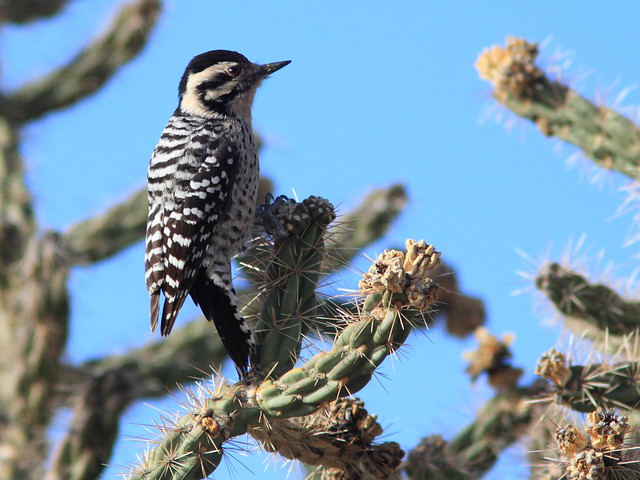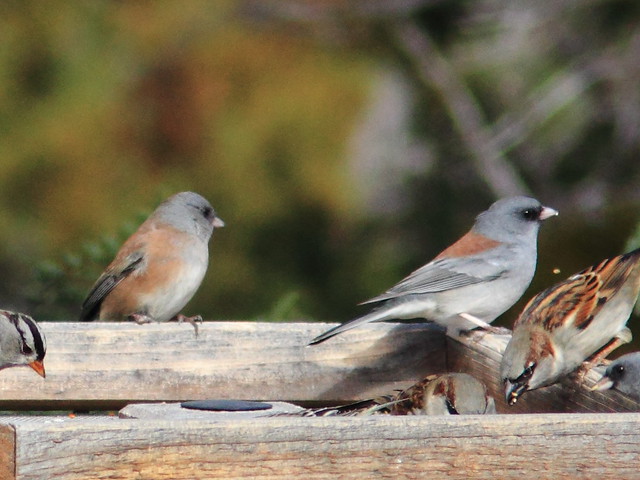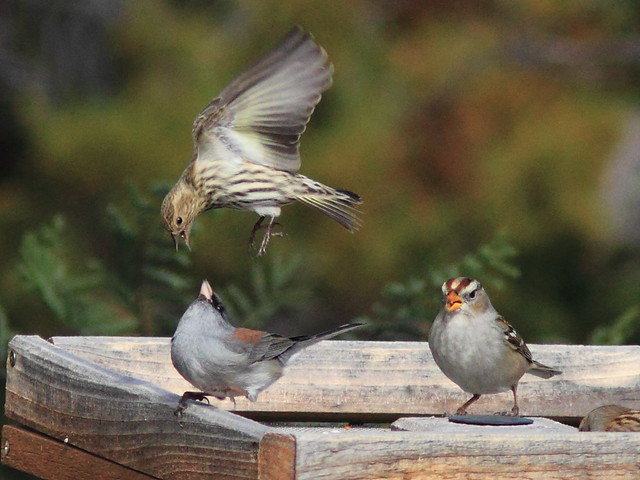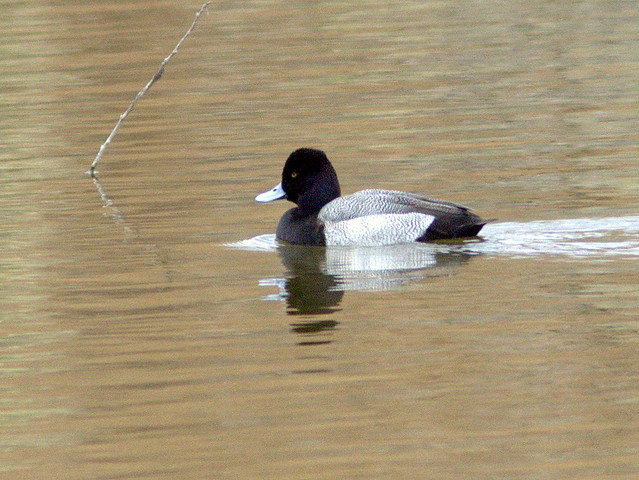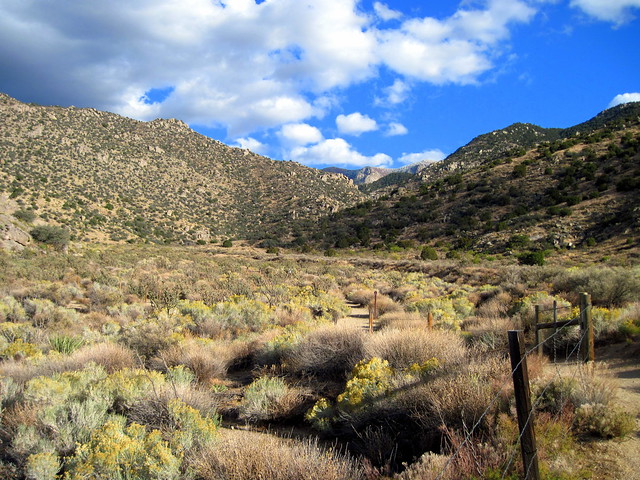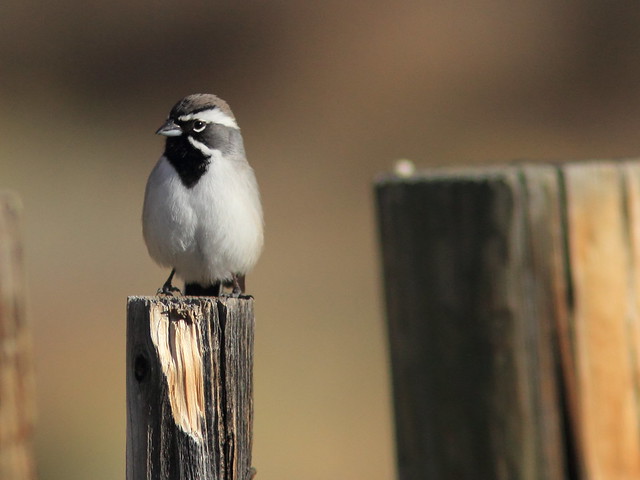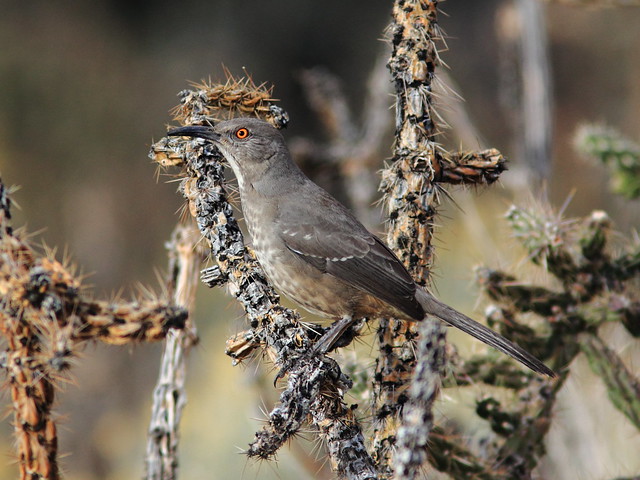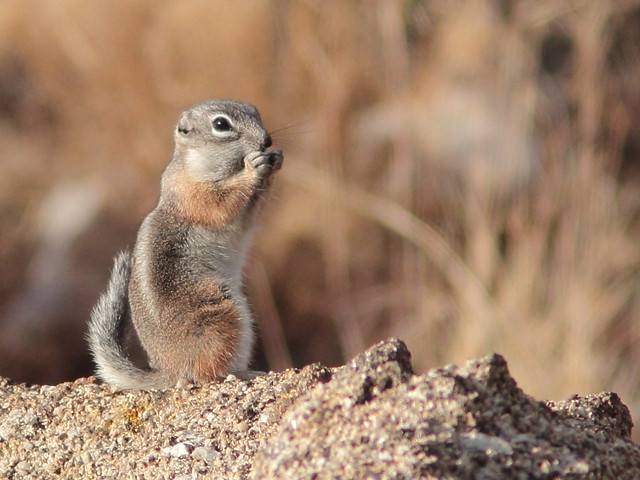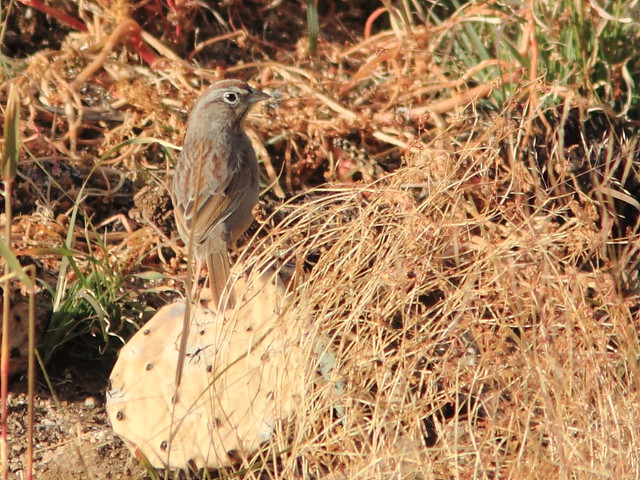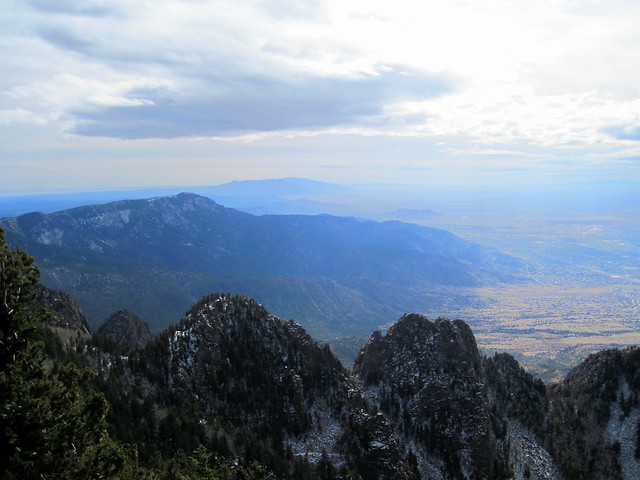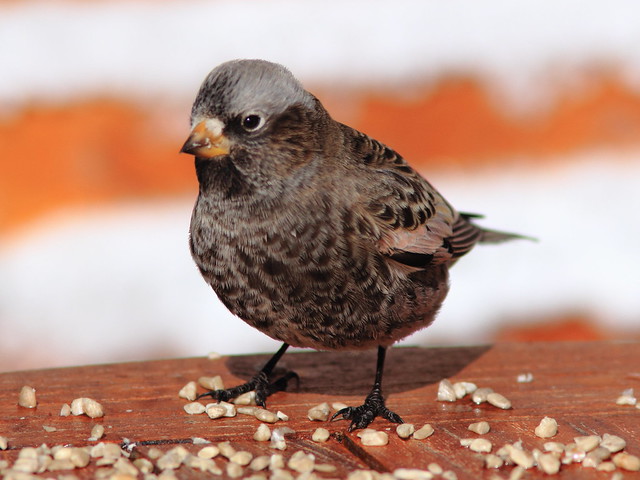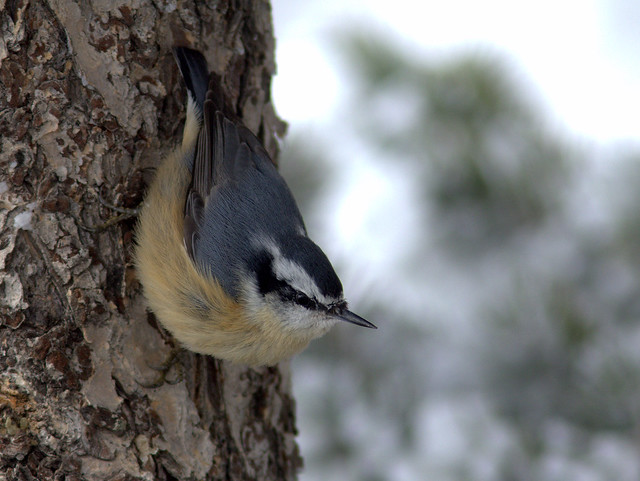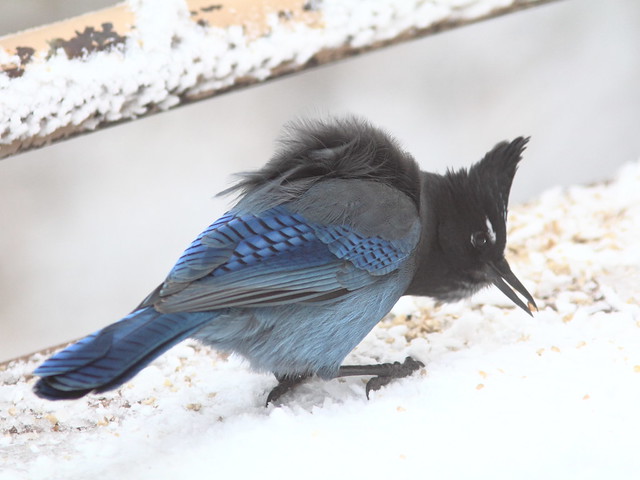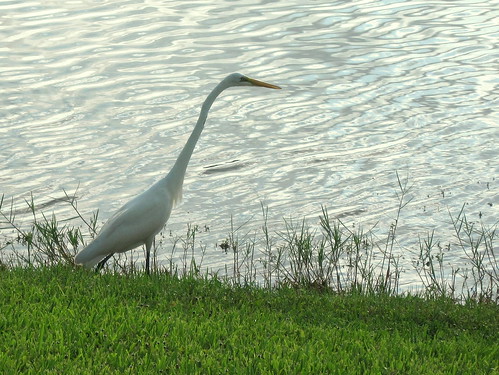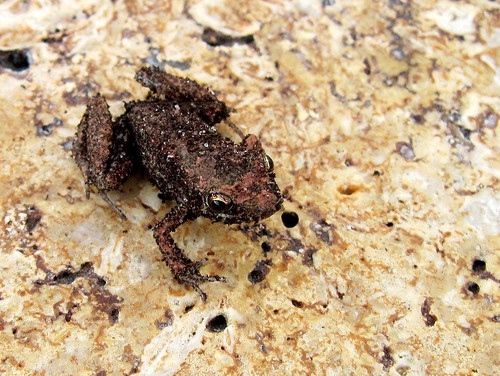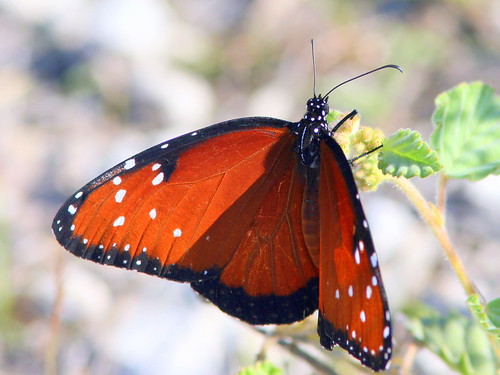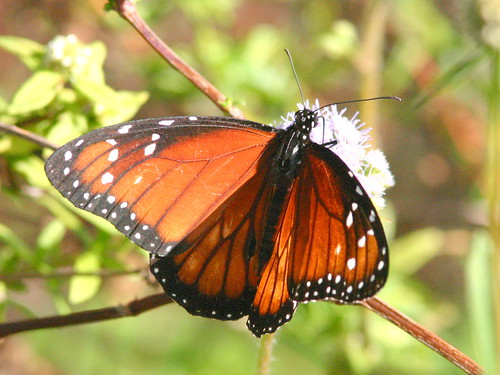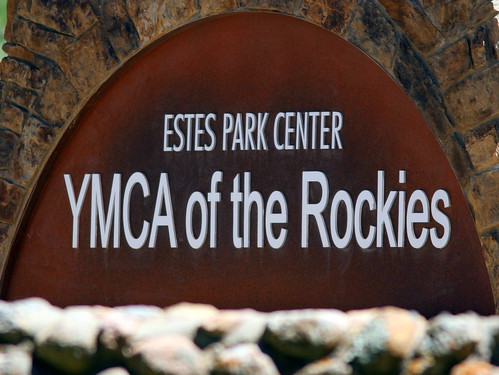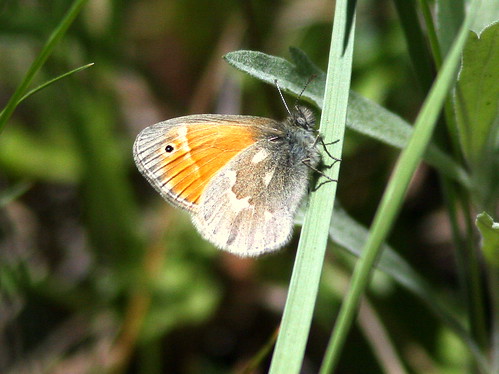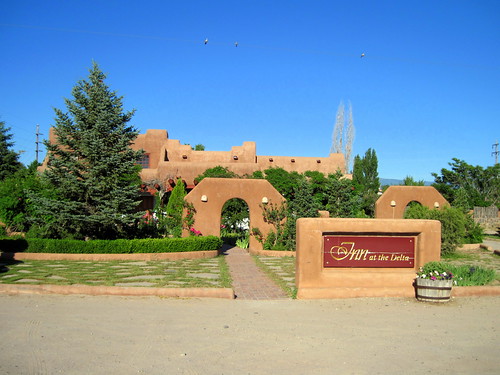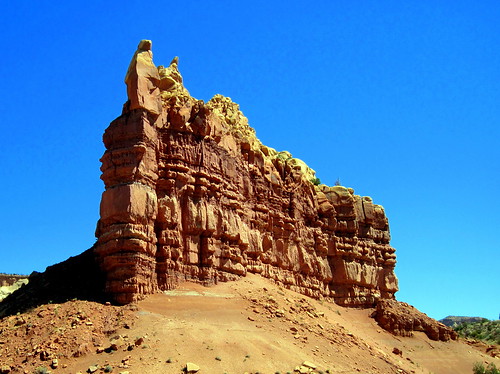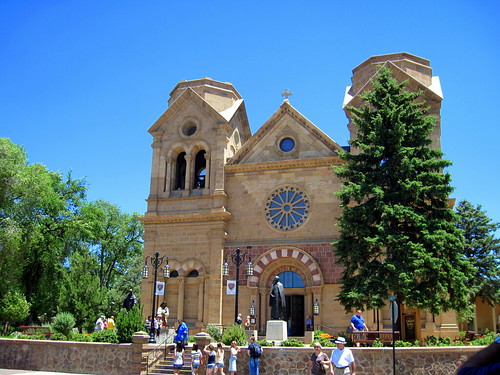Posted by: Ken @ 2:09 pm
We followed our recent trip to our son’s family home in the Texas Panhandle with a short visit to Albuquerque, where our main objective was to see the rosy-finches at Sandia Crest.
There are many great birding spots in and around Albuquerque. Judy Liddell and Barbara Hussey described them beautifully in their recently released book, Birding Hot Spots of Central New Mexico (See my review here). We only had time to bird a few of them. The City of Albuquerque manages an impressively large number of dedicated Open Spaces.
On our first full day, driving from our lodging in Albuquerque to Sandia Crest House, we encountered rain and low clouds as we ascended the east side of mountain. Since we knew that the temperature at the tip was in the twenties (F). we turned around and birded Tres Pistolas (Three Gun) Canyon.
This unimproved Open Space is just off I-40 in the southern foothills of the Sandia Mountains. This photo illustrates the vagaries of mountain weather. Although the sky is blue here and the temperature is in the mid-forties, it is snowing atop the mountains just a few miles beyond.
On the dirt road leading to Tres Pistolas, we encountered this Ladder-backed Woodpecker, busily foraging in a Cholla cactus.
We saw several Townsend’s Solitaires.
A feeder in the residential area next to Tres Pistolas was remarkably productive. Here, from left to right, a Pink-sided and a Gray-headed Junco, two subspecies of the Dark-eyed Junco, share a meal with a male House Sparrow.
An Oregon Junco also visited the feeder.
A feisty Pine Siskin squabbled with a Gray-headed Junco as a White-crowned Sparrow looked on.
From there we drove down to the Rio Grande Nature Center, where I had been a volunteer docent for eleven years, leading bird and general nature hikes. We parked and immediately walked over to the blind at the east end of the parking lot. We saw several Hooded Mergansers.
Inside the Interpretive Center, we were delighted to see our old friend, Sondra Williamson. Sondra was sitting on the couch in front of the big picture window that overlooks the pond, pointing out and identifying the ducks for visitors. A Ring-necked Duck and a Lesser Scaup provided an opportunity for her to compare their features.
There were several pairs of American Wigeons…
…and a spectacular male Wood Duck, roosting next to the pond before taking a swim.
A female Belted Kingfisher hunted from a perch on an island in the pond.
A Pied-billed Grebe flapped in place.
On our final full day, we again visited Sandia Crest, then explored the western foothills of the Sandia Mountains. Lomas Canyon Open Space provided a nice view of Albuquerque, but was not very birdy.
Embudito Canyon Open Space, not far away, offered a wonderful contrast. It was a bit greener than Lomas. There had been recent reports of a Golden-crowned Sparrow as well as Canyon Wrens.
As we entered the gate at Embudito, we were greeted by at least a half dozen Black-throated Sparrows.
Western Scrub-Jays were common.
Although they can be elusive, Canyon Towhees were abundant and out in the open.
Curve-billed Thrashers sat atop the tallest Cholla branches.
A little White-tailed Antelope Squirrel eyed us anxiously.
A Rock Wren scolded.
Time was running out, as we had a dinner date with some old friends and neighbors. We found neither the Golden-crowned Sparrow nor the Cactus Wren, though we did see a fresh nest belonging to the latter.
Unexpectedly, a Rufous-crowned Sparrow made an appearance. We had great binocular views, but I did not get very good photos.
Posted by: Ken @ 1:47 pm
In a random but unknowing act of kindness, the construction worker tossed his half-eaten sandwich on a snowbank along the road, and returned to his job. A small flock of dark-feathered birds flew down and shared the treat…
But, wait. I’m getting ahead of this story. I might have started with “It was a dark and snowy morning when we drove to the top of the world…” Instead, let’s begin by recollecting our repeated futile attempts to find rosy-finches on the top of Sandia Crest, 10,678 feet above sea level, near our previous home in New Mexico. Several times since moving there in 1993, Mary Lou and I would follow up on reports of rosy-finch sightings on or near the Crest, only to be disappointed.
“It was a clear and cold morning…” in early December, 1999 when we finally plugged three gaping holes in our life lists. We rejoiced while we watched about twenty birds, including all three rosy-finch species, as they devoured the aforementioned bread crusts at the site of the radio/TV transmission towers just across the parking lot from the Crest House Restaurant and Gift Shop.
The next morning we repeated the 13 mile drive up the Crest Road, carrying a supply of wild bird seed. Halfway up, snow started falling and we drove slowly to the top. We scattered seed generously on the snowbank where we had first seen the finches. They did not disappoint us, as within minutes a dozen or more appeared along with some juncos and they swarmed over the seed.
Upon revisiting a few days later we found that a snowplow had distributed the seed all along the roadway, burying some, and exposing the birds to a traffic hazard. This time we spread some seed on a windswept snow-free area on the upper parking lot. Every week until the end of February, 2000 we continued bringing seed, and birders started noticing the rosy-finches. The next winter we resumed our surreptitious feeding, and found that others were also scattering seed, not only on the parking lot surface, but also on ecologically fragile areas along the observation area at the top of Sandia Crest. We publicized our concerns on the Internet, and this resulted in our receiving dozens of inquiries about the rosy-finches. To manage the requests for information, we set up the rosyfinch.com website.
As Forest Service volunteers, we knew full well that wildlife feeding violated the agency’s policies, so we approached our friend Tom Duncan, who was then the resident manager of Sandia Crest House. He talked to Forest Service people and learned that the prohibition against feeding applied only to “undisturbed” land; the Forest Service interpreted any private leases or concessions within the National Forest boundaries to be “disturbed” land, thus exempting the Crest House.
Tom erected a feeder only about three feet outside the main entrance to the Gift Shop, and it immediately attracted rosy-finches. The trouble was that they were frightened away every time someone entered or exited, and they could not be observed from inside the building.
We engaged Central New Mexico Audubon, the US Forest Service, Crest House management as well as a local bird seed supplier in an agreement whereby three feeders were installed, to be maintained by Forest Service volunteers. Spurred on by enthusiastic younger birders, most notably the late Ryan Beaulieu and his friend, Raymond VanBuskirk, Rio Grande Bird Research, Inc., managed by Steve and Nancy Cox, expanded its operations to include weekly rosy-finch banding sessions at the Crest House during the winter months. Read more about Ryan’s untimely death and how Raymond helped carry on his legacy at the link to the June 2010 issue of Audubon Magazine on this page.
After Gene Romero took over as manager of Crest House, the facility was renovated to include an improved dining area with large picture windows that provide a clear view of the deck feeder. Gene and his staff have become avid watchers and protectors of the rosy-finches and, during the warm months, myriad hummingbirds that frequent their feeders. Local merchants donated feeders and seed, and Mary Lou and I coordinated the feeding program, driving up about twice a week to tend them. We moved away from New Mexico to Florida in 2004, and now Dave Weaver and his spouse Fran Lusso carry on as co-coordinators of the feeding project. For more information about the rosy-finches at Sandia Crest, see my Birder’s World article.
Since banding began in March, 2004 through the end of last winter, the team had accumulated a total of over 2200 newly banded rosy-finches. The species mix of newly banded birds is interesting. So far, 54% have been Black Rosy-Finches. The Brown-capped species made up approximately 28%, and Gray-crowned Rosy-Finches accounted for 18%. A little over half of the 432 Gray-crowned Rosy-Finches banded were Hepburn’s race, but of these 159 birds, most (133) were banded during the two winters of 2006-07 and 2007-08. Detailed results of banding are available here
Although we now have homes in Florida and Illinois, I remain a New Mexican at heart. Mary Lou? Well, she certainly enjoyed most of our eleven years of living at 7000 feet in the mountains of New Mexico, but not the winters. As she says, she was born in December and hasn’t thawed out yet! However, we had not seen our five Texas grandchildren since our 50th wedding anniversary reunion in the Colorado Rockies, over a year ago. We planned to fly to Amarillo for a “grandchildren fix” this fall, but it took a bit of effort on my part to convince her that we should fly home out of Albuquerque rather than Amarillo. After all, the cheaper return air fare would offset the incremental cost of a one-way car rental from Amarillo to Albuquerque. I also made sure that the trip occurred after the arrival of the rosy-finches to Sandia Crest. The first ones usually appear around the first of November, but this year they came in late. By November 9, no more than 6 Rosies had been seen at the feeder.
We had a very nice visit with our son, his wife and their five children, in Amarillo, Texas. On November 12, we drove west on I-40 to New Mexico. As we approached Albuquerque, we could see the snow-capped mountains of Santa Fe and Taos to the north, a promising sign, as snow cover tends to concentrate the rosy-finches at the feeder. We arrived at Sandia Crest around noon. It was a cold 29 degrees Farenheit, with a brisk southerly wind with gusts to 50 miles per hour.
This is the view to the south from the deck of Crest House.
There had been a dusting of snow the previous day, but the deck of the Crest House was clear. The feeder hangs over the far end of the railing; a hungry Abert’s Squirrel can be seen running along the top of the rail towards it (click on photo to select larger views).
We saw a total of six Rosy-finches on November 12. Among them, we identified three Black Rosy-Finches and one that looked like a Gray-crowned. This is a Black Rosy-Finch.
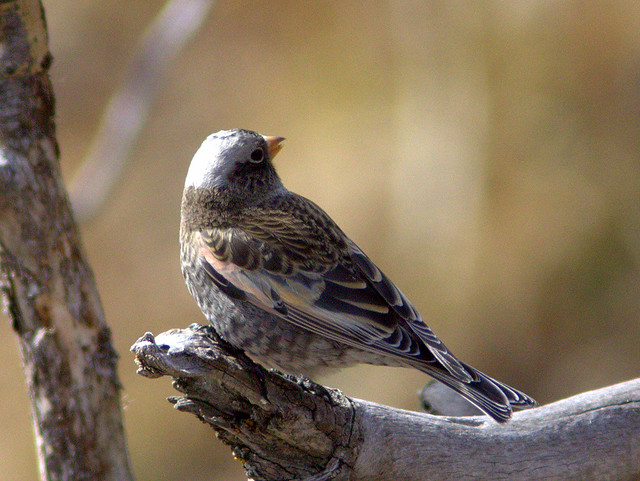
This bird that we first thought to be a Gray-crown was more brownish, but close examination of the photo reveals it to be an adult female Black Rosy-Finch. The angle of light caused reflection that made the bird look lighter than it really was.
An Abert’s Squirrel was dominating the feeder, and we had to chase it away repeatedly. The Rosies avoided the feeder when either the squirrel or a Steller’s Jay was present.
Mountain Chickadees shared the feeder…
…with Red-breasted Nuthatches…
…and the local Gray-headed race of the Dark-eyed Junco.
The next day, the forecast called for snow, but we ventured up Crest Road again. It started to rain as we checked for Pygmy Nuthatches at Doc Long Picnic Area near the base, and clouds enveloped the mountain. We turned back, deciding to bird around Albuquerque. We returned to the Crest on November 14, negotiating snow-packed areas on the road. Near the top, the moisture from the clouds had condensed to form a thick layer of hoarfrost on the trees.
Now there were flocks of up to 13 Black Rosy-Finches at the feeder. Here, two are perched on a frosty branch.
Before the banders introduced a degree of sophistication into our identification of the rosy-finches, we gave up on identifying many of the hatch-year birds, especially early in the season, as all have buffy brown tips on their contour feathers. At first we simply called them “Rosy-Finch sp.,” or “Buffies.” Now we know to take a closer look at the bases of the feathers. If they are black or very dark brown, and the bird has a whitish crown, it is a Black Rosy-Finch. Immature Gray-crowned Rosy-Finches have more cinnamon-brown feather bases. Male Blacks, even immature ones, show rather extensive pink on their underparts and wing coverts, while in females the color is very subdued. Even adult Gray-crowned Rosy-Finches show relatively little pink. This indeed is an immature (hatch year) female Black Rosy-Finch. Note the hint of pink on her shoulders and lower belly.
Our disappointment at not being able to positively identify any Gray-crowned Rosy-Finches was tempered by the appearance of the first Brown-capped Rosy-Finch of the season. Note its lack of a light crown and the more intense rosy undersides. A band from a previous season confirms that it is an adult.
Although the temperature had dropped to 22 degrees, the winds had died down, and photography conditions were much better than two days previously. Somehow, this beautiful adult black-Rosy-Finch had escaped the banding traps in previous years.
Though my fingers were about to freeze and drop off, I was able to get a nice shot of a Mountain Chickadee against a natural background…
..and a Red-breasted Nuthatch in a typical pose.
I shot this photo of a Steller’s Jay from inside the windows of the Crest House. Staff had spread the seed around to allow the finches to visit without being harassed by the jays.
Sandia Crest, just east of Albuquerque, New Mexico, is the most accessible site in the world where all three North American rosy-finch species can be seen at one time. We maintain the Sandia Crest Birding FORUM, where you will find interesting discussions on identification as well as updated sighting reports of not only the Rosies, but also such more unusual birds as Clark’s Nutcracker, Red Crossbill, Cassin’s Finch, Northern Pygmy-Owl and American Three-toed Woodpecker.
Posted by: Ken @ 9:54 am
Book Review: Birding Hotspots of Central New Mexico.
Judy Liddell & Barbara Hussey
W.L. Moody, Jr. Natural History Series
Texas A&M University Press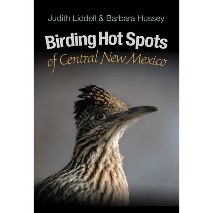
Many birders are familiar with Judy Liddell’s popular blog, It’s a Bird Thing. Judy’s blog entries often describe her local trips with the Thursday Birders, a dedicated group of Central New Mexico Audubon Society members who get out to interesting places every Thursday morning. The current schedule of Thursday Birder and other CNMAS field trips may be found at this link.
Most of the Thursday Birder excursions are in or around the city of Albuquerque for a half day, making it easy to fit them into a busy schedule. Reading her narratives brings me back to the eleven years I lived in New Mexico. (Please don’t ask why I ever moved to Florida!)
Here are a few birds I photographed in my back yard, located on the east side of the Sandia Mountains just outside Albuquerque. I put a little 2 megapixel point-and-shoot camera up to my spotting scope and shot through the glass of our living room. The quality of these early images may be poor, but the memories they elicit are vivid!
Williamson’s Sapsucker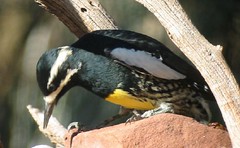
Cassin’s Finch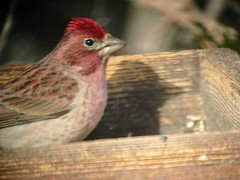
Pinyon Jay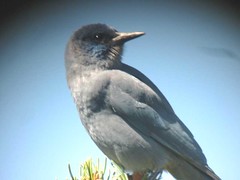
Blue Grosbeak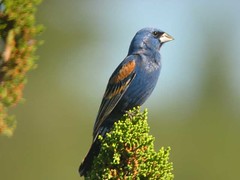
Judy is active in Central New Mexico Audubon Society. In addition to leading CNMAS bird walks, she serves as Vice President and Program Chair. She also is Secretary of New Mexico Audubon Council and is a bird monitor for the Rio Grande Nature Center.
With fellow birder and experienced birding guide Barbara Hussey, Judy has co-authored Birding Hotspots of Central New Mexico. In addition to long and dedicated service for the Rio Grande Nature Center, Barbara is a former President and Board member of CNMAS, and one of the founders of New Mexico Volunteers for the Outdoors.
This new site guide draws upon the authors’ familiarity with six clusters of the 29 very best birding locations within easy driving distance from downtown Albuquerque. Sample page views: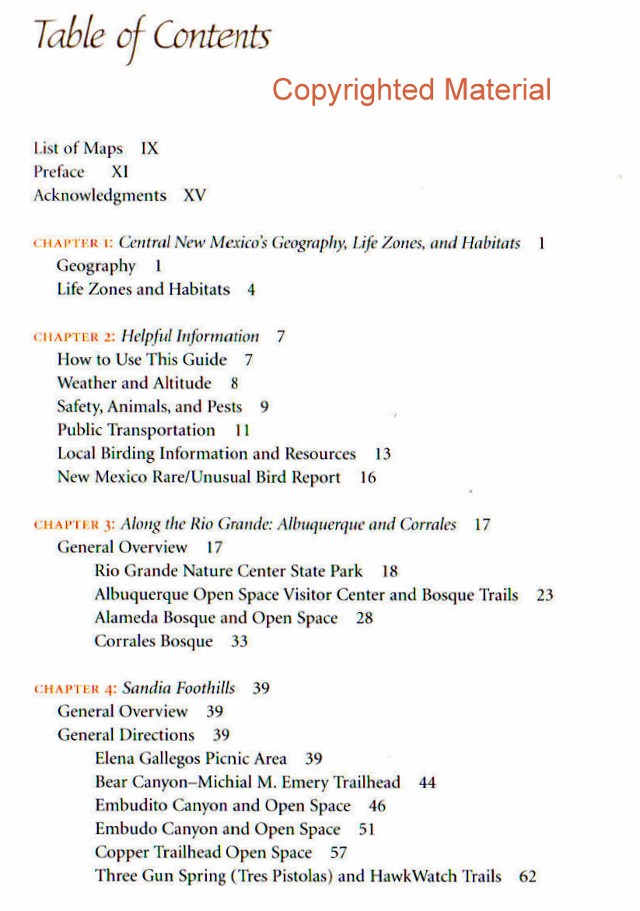
Each of the concise site descriptions stands alone, thus avoiding cross-references and conveying a marvelous sense of place. This assures most efficient use of the visitor’s time– by suggesting the best way to follow a trail, providing locations of the nearest rest rooms, drinking water, lodging and gas stations, and even spots for a picnic lunch. An annotated checklist links species to the best places to see them, and there are many colored photographs that enhance the descriptions of each hotspot.
Eleven detailed maps are provided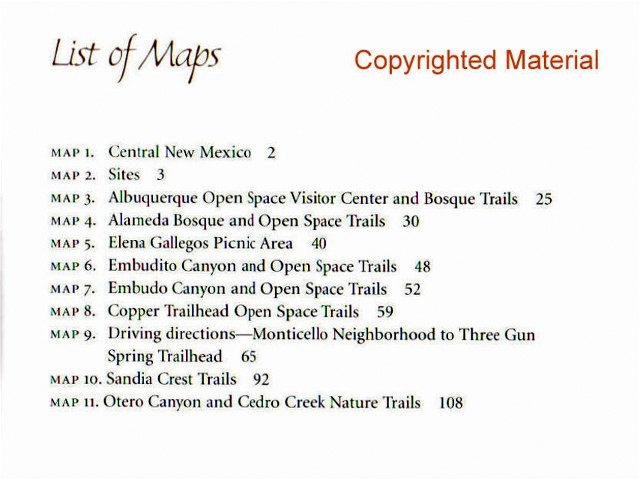
Road and trail conditions and elevation changes are carefully noted, as are hours of operation, any entrance fees and proximity of public transportation if available. Particular hazards are pointed out as may be necessary, as well as wheelchair accessibility and obstacles for those with limited mobility. At some sites, the visitor will know what time of day is most favorable for birding, and where to get the best views when the trees are bare or fields are flooded. Nearly a dozen maps complement site-specific driving directions that all start from the intersection of I-40 and I-25 in the heart of Albuquerque.
There is a strong emphasis on how to most efficiently locate target species, some of which may be found almost exclusively at one or a few of the hot spots. All of the expected species are listed in an annotated checklist that references only the best locations for finding them. 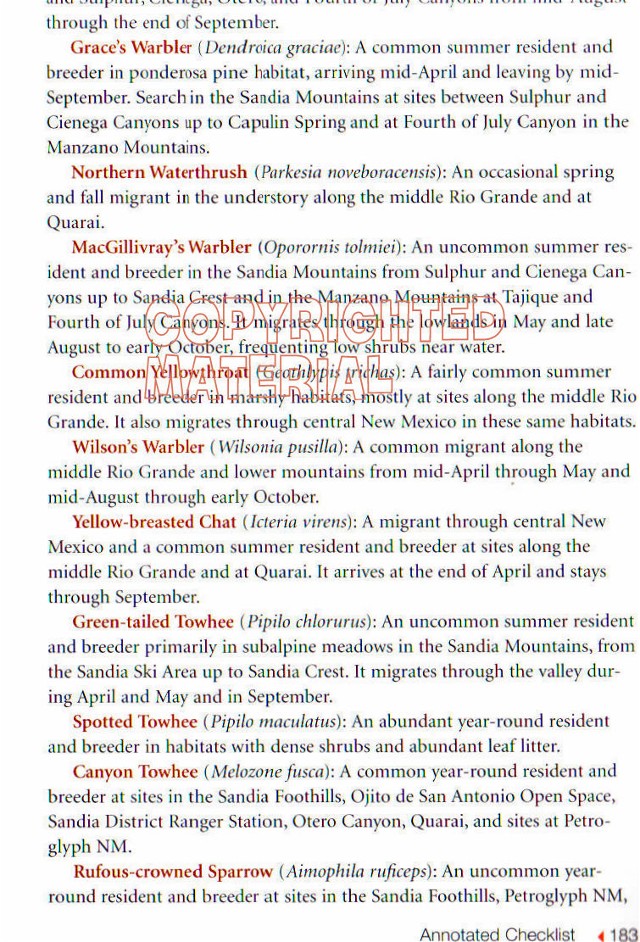
Unlike some bird finding guides, the text is not cluttered with aging reports of rare and unusual birds. Instead, the reader is sensibly advised to consult the latest eBird and rare bird alerts before setting out. Nearly all of these locations are already indexed by name in eBird.
The flaps of the sturdy softback cover can be conveniently used as bookmarks. They contain more information about the the book and its authors: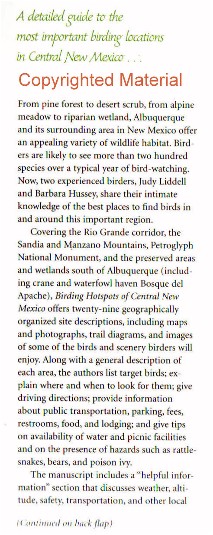
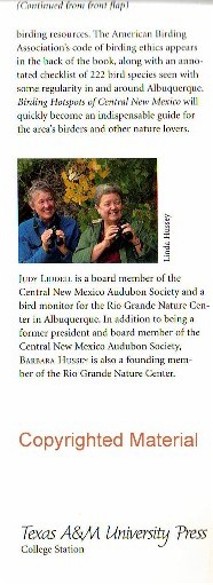
Whether planning an extended trip or a few hours’ escape from a business meeting, birders with all levels of experience will find Birding Hotspots of Central New Mexico an invaluable traveling companion.
Posted by: Ken @ 10:28 pm
Today, fast approaching the three-quarter century mark, I am penning my 300th post in Rosyfinch Ramblings. Before the days of File Transfer Protocol, and before the word “blog” was invented, I created the rosyfinch.com web suite devoted to the birds of the Sandia Mountains, near our former home in New Mexico. In those days I wrote daily updates in HTML code by hand, and uploaded strings of ASCII characters via a telephone modem. When I started using blogging software in 2006, I simply intended to record memories from my childhood in New Jersey. In my fifth post, Discovering Birds, I tried to remember how and why I ever got into bird watching.
How lucky I was to have had a father with an infectious interest in the natural world. I remembered those long walks with him in the woods (Habitats and Inhabitants) and, more recently on Father’s Day, described how I especially felt his his loss. Now we and our children try to inspire our grandchildren to put away the Wii’s, Game Boys and iPods and get outdoors. See Birders Start Young, and Early Birder.
I recounted adventures from my medical career, as the Rookie Doctor in Town , and wondered Why It’s Called Medical “Practice”. Then, suddenly and unexpectedly, I entered the field of public health, only two weeks after receiving a telegram: Greetings, You’ve Been Drafted . Providing medical care in the aftermath of Hurricane Camille, and Closing the Grand Canyon were but a couple of highlights of many exciting experiences in public health practice.
I always wanted to marry a bird-watcher, but this never happened until after I retired to the mountains of New Mexico. Don’t look so startled– Mary Lou and I just celebrated our 50th Wedding Anniversary, but she suffered as an SOB (spouse of a birder) for many years before I could say “Finally, I’m Married to a Bird-Watcher.“
We do not feel the need to travel far and wide to enjoy the beauty of nature, whether from the windows of home, in backyards, or in local patches of semi-wild land. From early childhood, I have found Beauty in the Commonplace, mostly in the good old USA. While Mary Lou and I keep life bird lists, and have taken several wildlife-oriented jaunts and cruises, neither of us has a compulsion to see all the birds of the world. We greatly enjoy seeing just that tiny sample of the avian multitude that live in, or visit our neighborhood.
Muscovy Duck in flight:
No, this is not a Frog-mouthed Four-legged Crow, but rather part of a ritualistic encounter between two male Boat-tailed Grackles in our yard. They take turns posturing, and soon one will open his mouth and flap his wings while the other points his bill to the sky. They posture and then the other bird does the same. At no time did both birds sing and flap at the same time. This went on for several minutes, until they peacefully walked away from each other and resumed catching dragonflies on the lawn. Click on image and view sequential photos of the “dance” at the “comment” link below the photo.
Boat-tailed Grackles perform a ritual “dance:”
I’m still experimenting with my little Canon A-1100 IS point-and-shoot. It packs 12.1 megapixels. This is a cropped image zoomed 4x optically to about 25 mm focal length. If you click on the photo, an image will appear below it, lightly cropped and not zoomed at all, about 6mm focal length:
Great Egret:
The Canon A-1100 takes surprisingly sharp macro photos, such as of this Garden Snail (Zachrysia provisoria):

This big Lubber grasshopper was on the glass of our patio door, again captured by my little point-and-shoot:
I had been hearing little chirps in my garage in the vicinity of the corner where I store my fertilizer and garden stuff. The chirps would stop whenever I got near, and I could not find their origin, though I presumed it might be a tree toad or frog, or maybe a Mediterranean Gecko. When potting a plant one morning I reopened a bag of potting soil. Inside were at least 6 or 7 of these little frogs, about 3/4 inch in length. Greenhouse Frogs live in plant litter and their tadpoles develop into frogs inside the eggs, so they don’t need a pool or pond to breed. They lack webbing between their toes and have been erroneously called toads. Native to the Caribbean, they have invaded most of the Florida peninsula. Listen to an mp3 of their little chirps that I heard: puca.home.mindspring.com/mp3s/Greenhouse.Frog.mp3
A Green Heron dropped by our back patio just before we departed for Illinois:
When the birding slows down there are always butterflies, and it is fun to separate the Queen…
Posted by: Ken @ 3:34 pm
YMCA entrance sign:
(Continuation of previous post)
We last visited the YMCA of the Rockies in Estes Park, Colorado several times in the 1970s and ’80s, when I attended continuing medical education conferences of the American Academy of Family Physicians. I combined the trips with a few vacation days. We’d pack our children into the station wagon and drive up from Dallas. The children were kept busy with Day Camp programs, and the conference schedule allowed us for family fun, such as hay rides, hiking and sightseeing. Although the facility is now much larger, the cabins are stil fairly secluded. As their parents had before them, our grandchildren also enjoyed a wonderful selection of Day Camp activities.
Our cabin (Robin’s Nest), at 8,500 feet elevation, was flanked by those of our children and grandchildren:
Missing from this photo of the Schneider clan are our daughter Karen and her husband Randy, who had to return home because of his brother’s sudden death, and our son-in-law Roly, who took the picture: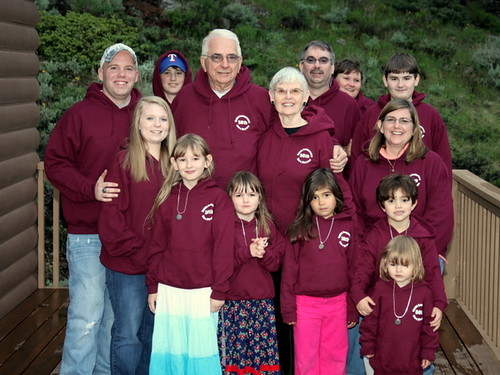
Bachelor groups of elk gathered near the cabins. In the fall they will fill the air with their bugling, and compete with each other as they assemble the females into harems: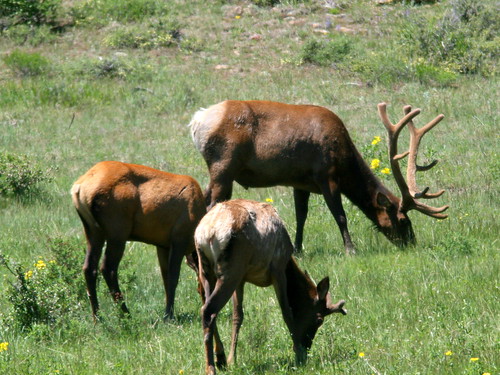
A Pine Siskin gathered nesting materials beside our cabin:
This Tiger Swallowtail provided a photo-op::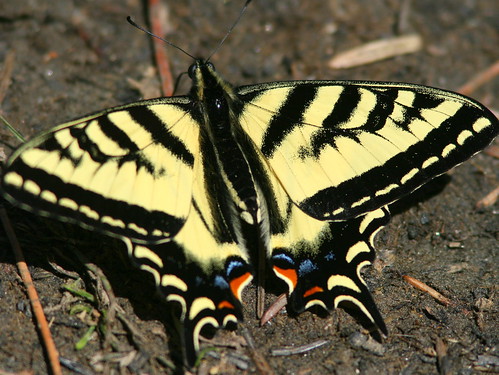
Having left my butterfly guide back in Florida, I found this Common Ringlet, a species that has expanded its range southward from Canada:
We joined our younger daughter and family on a scenic drive through southern Colorado to New Mexico, staying two nights at The Inn on the Delta in Espanola:
The rooms were cozy and luxurious:

A male House Sparrow perched in the Inn’s courtyard:
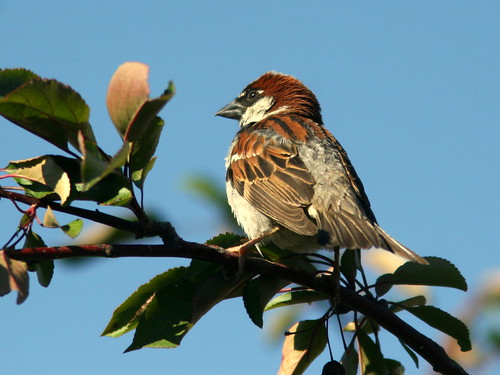
We made side trips to Abiquiu and Ghost Ranch, NM, and to Taos Pueblo. The vibrant colors and forbidding topography of Ghost Ranch inspired many of Georia O’Keefe’s paintings:
The hills, sculpted by wind and water, are rich in fossils:
Remarkably, a pair of Barn Swallows had plastered their mud nest on the smooth metal surface of one of the portal lights at the museum at Ghost Ranch: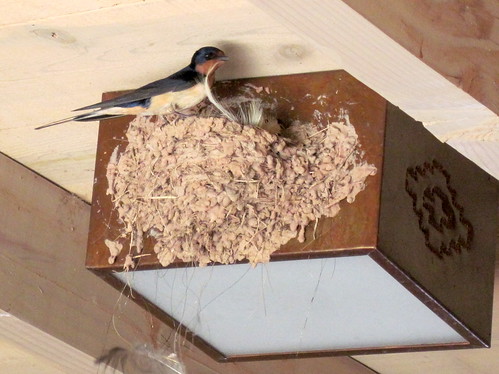
After two nights in Espanola, we departed for Albuquerque by way of Santa Fe, where St. Francis of Assisi Cathedral loomed over the old city:
In Santa Fe’s Central Plaza, our granddaughters made friends with two vendors and a macaw: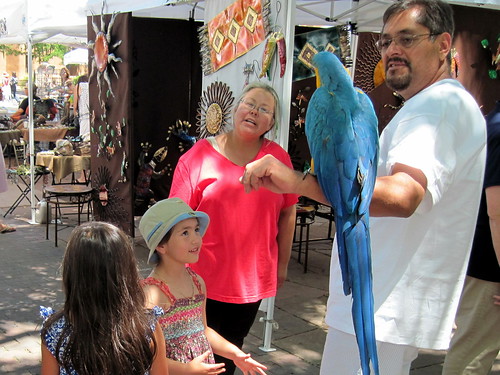
Following the Turquoise Trail southward, we drove up to Sandia Crest before descending into Albuquerque. The hummingbird feeder at Crest House attracted quite a crowd of Broad-tailed Hummiingbirds. Here, a male hovers, a mile above the City of Albuquerque: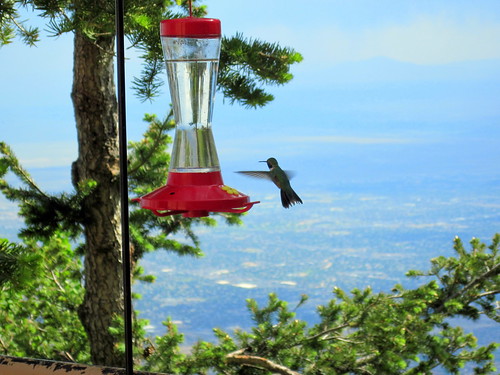
Before departing for California, we visited the ancient Acoma Pueblo, situated west of Albuquerque, high on an arid mesa. At bottom of this page, view a slide show of the Pueblo (select full screen mode). This is the Acoma mission church:














